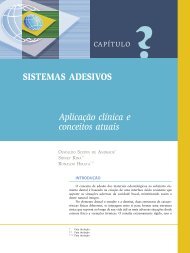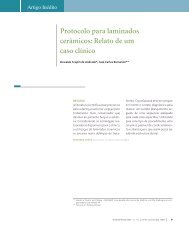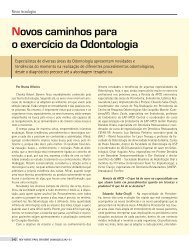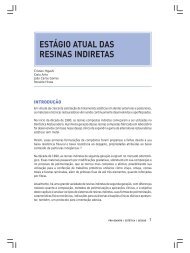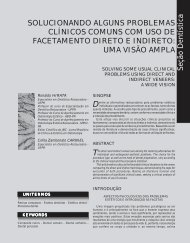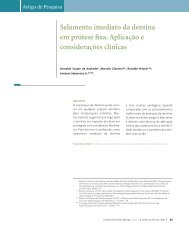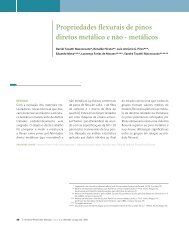Avaliação comparativa da translucidez do esmalte dentário e de ...
Avaliação comparativa da translucidez do esmalte dentário e de ...
Avaliação comparativa da translucidez do esmalte dentário e de ...
Create successful ePaper yourself
Turn your PDF publications into a flip-book with our unique Google optimized e-Paper software.
Milko Villarroel, Ronal<strong>do</strong> Hirata, Andrea Maria <strong>de</strong> Sousa<br />
sobre seu grau <strong>de</strong> <strong>transluci<strong>de</strong>z</strong>, são consi<strong>de</strong>ra<strong>da</strong>s<br />
como principais objetivos na tentativa<br />
<strong>de</strong> imitar as proprie<strong>da</strong><strong>de</strong>s ópticas <strong>do</strong>s teci<strong>do</strong>s<br />
<strong><strong>de</strong>ntário</strong>s 11,15 .<br />
Nossos resulta<strong>do</strong>s estão coerentes com os<br />
obti<strong>do</strong>s por Craig 6 , Fontana et al. 12 , Jardim et<br />
al. 14 , Panzeri et al. 18 e Villarroel et al. 24 , que em<br />
estu<strong>do</strong>s <strong>de</strong> <strong>transluci<strong>de</strong>z</strong> <strong>do</strong>s materiais resinosos<br />
em espectrofotômetro ou em aparelho <strong>de</strong><br />
eletroforese “Jouan”, mostraram diferente níveis<br />
<strong>de</strong> <strong>transluci<strong>de</strong>z</strong> para os materiais estu<strong>da</strong><strong>do</strong>s.<br />
A diferença <strong>de</strong> <strong>transluci<strong>de</strong>z</strong> <strong>de</strong>tecta<strong>da</strong> para<br />
os materiais estu<strong>da</strong><strong>do</strong>s <strong>de</strong>ve estar relaciona<strong>da</strong><br />
com a composição <strong>de</strong> ca<strong>da</strong> um <strong>do</strong>s materiais,<br />
especificamente ao tipo, quanti<strong>da</strong><strong>de</strong> e tamanho<br />
<strong>da</strong>s partículas <strong>de</strong> carga.<br />
CONCLUSÃO<br />
De acor<strong>do</strong> com a meto<strong>do</strong>logia emprega<strong>da</strong><br />
foi possível concluir que:<br />
• Os valores <strong>de</strong> <strong>transluci<strong>de</strong>z</strong> <strong>da</strong>s resinas<br />
compostas para <strong>esmalte</strong> apresentaram gran<strong>de</strong><br />
variação entre os grupos;<br />
• Os grupos III (4 seasons enamel super clear),<br />
IV (Miris NT), VIII (Amelogen PF-A) e X (4 seasons<br />
enamel clear) apresentaram os valores <strong>de</strong><br />
<strong>transluci<strong>de</strong>z</strong> estatisticamente mais semelhantes<br />
ao grupo I (<strong>esmalte</strong>);<br />
• Os valores máximo e mínimo <strong>de</strong> <strong>transluci<strong>de</strong>z</strong><br />
foram <strong>da</strong><strong>do</strong>s pelos grupos V Vitalescence<br />
TM) e VI (Filtek A110 A2E) respectivamente,<br />
apresentan<strong>do</strong> diferenças significantes com o<br />
grupo I (<strong>esmalte</strong>).<br />
Comparative evaluation of the translucity of the<br />
<strong>de</strong>ntal enamel and composed resins for enamel<br />
Due to esthetical exigency, restorative <strong>de</strong>ntistry<br />
tries to imitate the natural characteristics<br />
of human teeth. Because of this, many last<br />
generation resin composites provi<strong>de</strong>, within<br />
their optical properties, a translucity similar<br />
to natural <strong>de</strong>ntition. This study evaluates and<br />
compares the translucity of <strong>de</strong>ntal enamel and<br />
of nine enamel resin composites. Five testing<br />
bodies were manufactured using a quadrangular<br />
metallic matrix for each group, which are:<br />
GI or control (<strong>de</strong>ntal enamel), GII (Esthet X YE),<br />
GIII (4 Seasons enamel super clear), GIV (Miris NT),<br />
GV (Vitalescence TM), GVI (Filtek TM A110 A2E),<br />
GVII (Concept® A2Be), GVIII (Amelogen PF-A),<br />
GIX (Filtek TM Supreme B1E) and GX (4 Seasons<br />
enamel clear). Translucity evaluation was performed<br />
by the Transmission Spectrophotometer FTIR 8400<br />
– Shimadzu. The <strong>da</strong>ta obtained was subjected to<br />
Anova test (Bonferroni) for statistical analysis,<br />
using a 5% significance level (p< 0.05). The results<br />
<strong>de</strong>monstrated a great variation in the translucity<br />
values between the study groups. Accordingly<br />
to the metho<strong>do</strong>logy used, we can conclu<strong>de</strong> that<br />
there are different grates of translucity in the<br />
evaluated resin composites. GIII, GIV, GVIII and<br />
GX provi<strong>de</strong>d a translucity statistically similar<br />
to GI. The highest and lowest grates were<br />
obtained, respectively, by GV and GVI; both of<br />
them presented a significant difference when<br />
compared to control group.<br />
KEY WORDS: Dental enamel. Resin composite. Translucity.<br />
R Dental Press Estét - v. 2, n. 3, p. 22-34, jul./ago./set. 2005<br />
33




